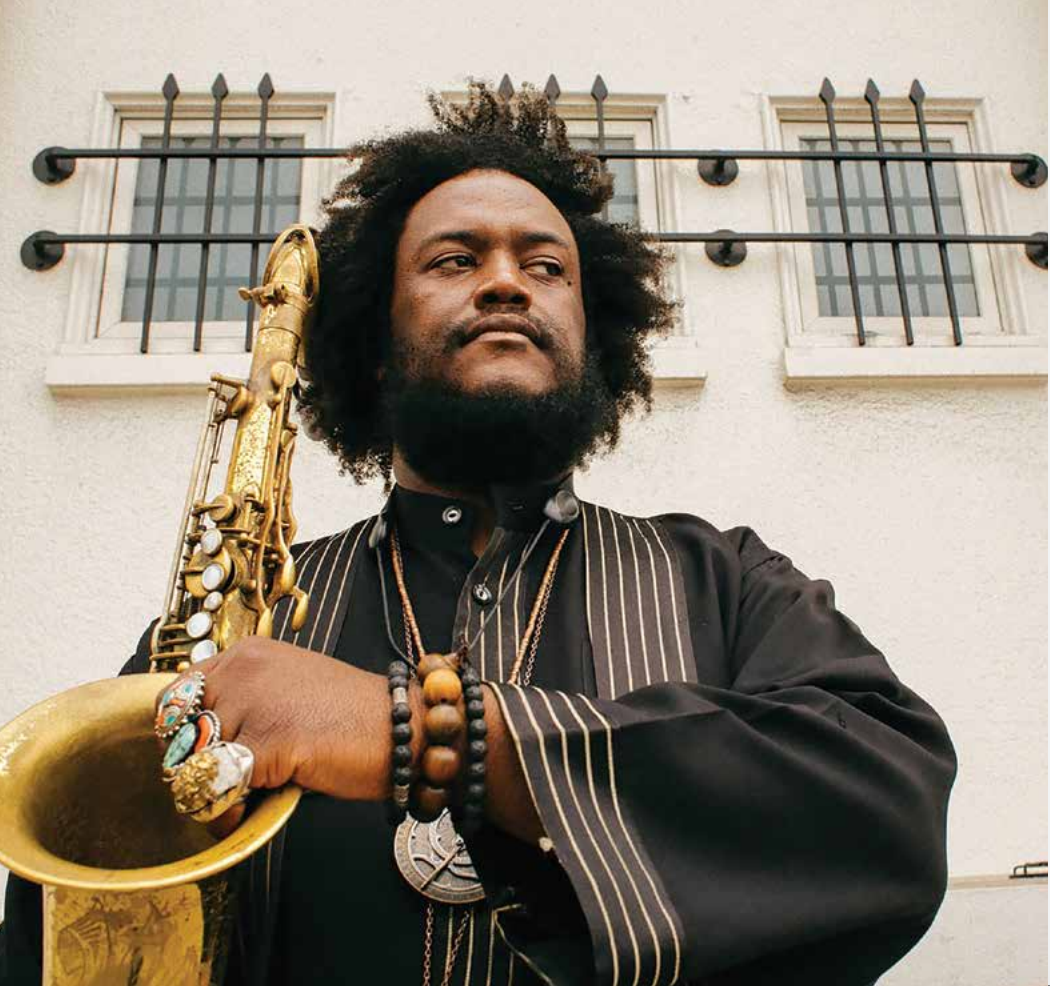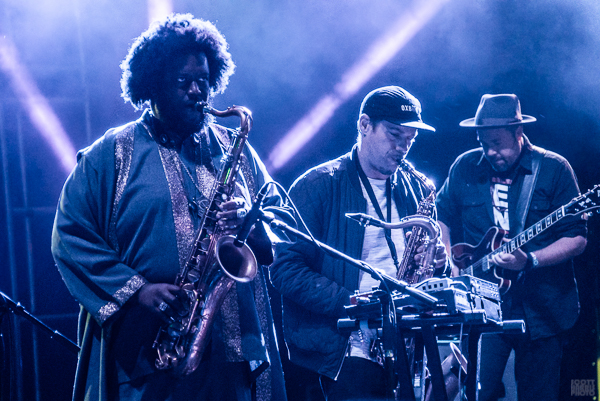Sounds of Summer: Kamasi Washington
 Kamasi Washington’s The Epic, one of 2015’s most critically acclaimed albums, nearly wasn’t so epic. With 17 tracks, none shorter than 6:31, spread out over three CDs—just short of three hours of music total—the breakout release from the saxophonist/composer from Los Angeles topped just about every year-end jazz poll and garnered rave reviews from virtually every publication that covers contemporary jazz.
Kamasi Washington’s The Epic, one of 2015’s most critically acclaimed albums, nearly wasn’t so epic. With 17 tracks, none shorter than 6:31, spread out over three CDs—just short of three hours of music total—the breakout release from the saxophonist/composer from Los Angeles topped just about every year-end jazz poll and garnered rave reviews from virtually every publication that covers contemporary jazz.
But, the 35-year-old Washington admits that it wasn’t until he was well into the project—which he began conceptualizing and recording in 2011—that he realized it had to take on such prodigious proportions. “I was always trying to make it one disc!” he says, speaking by phone shortly before heading out on a summer tour that will find him playing major festivals and several headlining dates with his longtime band. “When we went in to record, my plan was to create about 80 minutes of music. But I found a complete statement in the 17 songs that ended up on the record and, for a year and a half, I was trying to go back to square one to figure out how to make them fit into one CD. Then I realized I don’t need to shrink it. I need to expand it. Each of those songs has its own purpose. If you take something away, there would be something missing. This is the album.”
Informed by a wide range of often disparate jazz ideas, and absorbing soul, pop and R&B elements before being bolstered with cinematic choir and strings, The Epic was released last May on Brainfeeder Records, the label founded by producer, DJ and musician Flying Lotus. But it wasn’t the only—or even the first—2015 release to throw a spotlight on Washington’s performing and compositional abilities. Two months earlier, Washington was name-checked as one of the featured musicians on Kendrick Lamar’s To Pimp a Butterfly, the runaway hip-hop release of the year, on which Washington both blew saxophone and arranged strings.
“[Musician and producer] Terrace Martin, a guy who I grew up with and a great saxophone player, pulled me into that project,” says Washington about the Lamar sessions. “I’d been hearing about Kendrick for years, since like 2008. Terrace had been telling me how brilliant this young dude was, who he was working with. Terrace and [bassist/producer] Thundercat and all these other guys had been working on Kendrick’s new record for a long time, like years. I didn’t really know what they were doing. Then Terrace said, ‘I’ve got something I need you to do for Kendrick’s record.’ I heard what they were working on and I was really blown away. Then, every time Terrace played the record for me, he had something different he wanted me to do. It started off with just one song.”
By the middle of last year, after more than a decade of making music with friends and securing recording and performing gigs at a steadily accelerating pace with a wildly diverse collection of artists— from Snoop Dogg to the late nonagenarian trumpeter Gerald Wilson—Kamasi Washington was suddenly hailed as both a savior of jazz and the guy who gave To Pimp a Butterfly so much of its splashy expansiveness.
To Washington, there’s a fine line between what he and artists like Lamar are creating. “What people like Thundercat and Lotus and Kendrick are doing is showing connections,” he says. “There’s a perception that jazz is separate. What they’re doing is putting it into the forefront, opening people back up to the idea of jazz. They’re changing the perspective as to what jazz is. It’s not some old music meant to be a historic reference. It’s something that is super freeing and expressive, and the energy you get from it is to be free and be yourself.”
Kamasi Washington grew up in a musical family in Inglewood, Calif., and knew early on that he would play. His first instrument was clarinet and— in an oft-told story that he swears isn’t apocryphal—one day, the young Kamasi picked up a soprano saxophone his dad had left lying on the family piano and, first time out, played a Wayne Shorter tune as if he’d been taking lessons for years. He played music throughout high school—gigging at the Playboy Jazz Festival at 14 with the school band—and then enrolled at UCLA, where he studied ethnomusicology. He considers his formal music education vital to his growth.
“I heard a lot of different music from around the world I wouldn’t have even known existed,” he says, “and I also had a composition emphasis, so I was learning how to write for orchestras—things that I don’t know I would have just stumbled upon. So now, when I go searching for music, I’m searching from a wider perspective.”
Washington was also extremely fortunate to have befriended fellow musicians at a young age that all came up together, playing on one another’s sessions. Calling themselves the West Coast Get Down, these same friends ultimately became the core band on The Epic and several remain in Washington’s touring group. “There was a certain sound we had when we played together and I wanted to capture that— that was the seed of it,” he says of the making of the sprawling triple-disc juggernaut. During a month of marathon sessions, the ensemble laid down nearly 200 tracks, some of which ended up on Washington’s album and others ultimately destined for other projects. The Epic runs from edgy post-bop to quasi-fusion, impressionistic ballads to deep funk to freeform freakouts—most of the music is credited to Washington, with three consecutive covers (Ray Noble’s “Cherokee,” Debussy’s “Clair de Lune” and a Terence Blanchard number) occupying much of disc three. There are vocal numbers amid the jams, but, perhaps surprisingly, he only hints at hip-hop.
“We were all really focused and driven, and we were grooming ourselves to be what we wanted to be in life,” Washington says of his crew. “A lot of us are second-generation musicians, and even though we’re doing well, we were basically playing for other artists, and there’s a certain dead-end trap to that. So we took a month to just record, and we did it out of pocket.”
Even after The Epic was released, Washington wasn’t finished with it. He sees it as “an infinite work in progress” that changes each time the band performs the music onstage. “There’s always the starting place and a possible ending,” Washington says. “When we’re playing, it just evolves within the song. The energy we have is completely free and each person can influence the direction. Somehow, we end up exactly where I want to be at the end of a song.”
Now that The Epic has already been out for more than a year, Washington is looking forward to whatever comes next. This summer, he’ll lead the annual Bonnaroo SuperJam—the theme is the music of Tennessee. “So many great musicians came out of Tennessee,” he says, checking off Yusef Lateef, B.B. King, Tina Turner, Aretha Franklin, Bobby “Blue” Bland, Dolly Parton, Bessie Smith and even Justin Timberlake. “It’s been really fun just making the setlist. We started off at 200 songs and we reduced it to 19. We’re gonna go all over the place.”
And then what? Might there be another “epic” studio project? “I have a bunch of music,” he says. “I always look at an album as a statement. Some statements are long and some statements are short. By the time The Epic came out, we had already moved on. There’s a lot of information in my music; there’s a lot of influences, a lot of subtle nuances. But then, there are a lot of things in it that people haven’t heard and haven’t experienced. But it’s about timing, too—sometimes it’s about when you put an album out, and if the world is looking for it.”



















